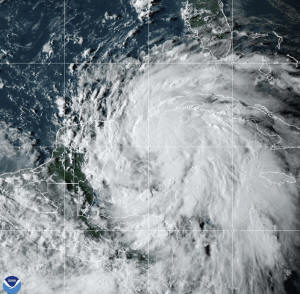Tropical Storm Helene strengthens as hurricane warnings cover parts of
Florida and Mexico
 Send a link to a friend
Send a link to a friend
 [September 25, 2024]
By HEATHER HOLLINGSWORTH and LUIS ALBERTO CRUZ [September 25, 2024]
By HEATHER HOLLINGSWORTH and LUIS ALBERTO CRUZ
Tropical Storm Helene was rapidly strengthening in the Caribbean Sea and
expected to become a hurricane Wednesday while moving north along
Mexico's coast toward the U.S., prompting residents to evacuate, schools
to close and officials to declare emergencies in Florida and Georgia.
The storm is forecast to be “near hurricane strength” when it passes
near Mexico's Yucatan Peninsula early Wednesday, the U.S. National
Hurricane Center said, and to “intensify and grow in size” as it moves
north across the Gulf of Mexico. Heavy rainfall was forecast for the
southeastern U.S. starting Wednesday, with a “life-threatening storm
surge” along the entire west coast of Florida, according to the center.
Forecasters warned of the possibility of tornadoes Wednesday night over
parts of the western Florida peninsula and southern Alabama, and said
the tornado risk would increase Thursday, expanding across Florida and
into parts of Georgia and South Carolina.
Helene is expected to become a major hurricane — a Category 3 or higher
— on Thursday, the day it's set to reach Florida's Gulf Coast, according
to the hurricane center. The center has issued hurricane warnings for
part of Mexico’s Yucatan Peninsula and Florida's northwestern coastline,
where large storm surges of up to 15 feet (4.5 meters) were expected.
In Mexico Beach, along the Gulf Coast in Florida’s Panhandle, Hal
Summers said he’s taking no chances, and is heading inland to stay with
a friend.

The restaurant worker said he barely survived Hurricane Michael, a
Category 5 hurricane, that struck Mexico Beach in 2018. That storm
rapidly intensified and caught residents off guard before plowing a
destructive path across the western Florida Panhandle. He recalled
wading through rising water with his cat in his arms to get to safety.
His home was destroyed.
“That was such a traumatic experience that that is not the place I
needed to be for myself,” Summers said.
Mexico is still reeling from former Hurricane John battering its other
coast. John hit the country's southern Pacific coast late Monday,
killing two people, blowing tin roofs off houses, triggering mudslides
and toppling scores of trees, officials said Tuesday.
John grew into a Category 3 hurricane in a matter of hours Monday and
made landfall about 80 miles (128 kilometers) east of the resort of
Acapulco, near the town of Punta Maldonado, with maximum sustained winds
of 120 mph (193 kph) before weakening to a tropical storm after moving
inland.
Helene, which formed Tuesday in the Caribbean, is expected to move over
deep, warm waters, fueling its intensification. People in regions under
hurricane warnings and watches should be prepared to lose power and
should have enough food and water for at least three days, forecasters
warned.
On Wednesday morning, Helene was located about 60 miles (100 kilometers)
east-northeast of Cozumel, Mexico, and about 100 miles (160 kilometers)
west-southwest of the western tip of Cuba as it moved northwest at 9 mph
(15 kph) with maximum sustained winds of 70 mph (110 kph).
Tropical storm warnings were in effect for the upper Florida Keys, the
southern Florida Peninsula, the northeast coast of Florida and were
extended northward on Wednesday morning to Altamaha Sound, Georgia. A
tropical storm watch was in effect for the South Carolina coast north of
the Savannah River to the South Santee River.
[to top of second column]
|

This National Oceanic and Atmospheric Administration satellite image
taken at 6:10pm ET shows Tropical Storm Helene off the Gulf Coast of
Florida near Mexico and Cuba on Tuesday, Sept. 24, 2024. (NOAA via
AP)

Hurricane watches — which are a step down from warnings — were also
in effect for parts of western Cuba and Florida, including the Tampa
Bay area, the hurricane center said.
“It’s going to be a very large system with impacts across all of
Florida,” said Larry Kelly, a specialist at the hurricane center.
Several counties on Florida's west and northwestern coasts have
issued evacuation orders. Multiple school districts, including in
the areas around Tampa and the state capital Tallahassee, plan to
close schools or reduce hours starting Wednesday.
Some residents started filling sandbags ahead of anticipated
flooding and began leaving areas on the coast.
President Joe Biden declared an emergency in Florida and deployed
Federal Emergency Management Agency teams to Florida and Alabama to
support local first responders. Federal authorities were positioning
generators, food and water, along with search-and-rescue and power
restoration teams, the White House said.
Florida Gov. Ron DeSantis also issued an emergency for most of the
state's counties, while Georgia Gov. Brian Kemp declared an
emergency in his state as well.
The storm is anticipated to be unusually large and fast-moving,
meaning storm surges, wind and rain will likely extend far from the
storm’s center, the hurricane center said. States as far inland as
Tennessee, Kentucky and Indiana could see rainfall.
Heavy rains and big waves lashed the Cayman Islands on Tuesday.
Officials there closed schools, airports and government offices as
strong winds knocked out power in some areas of Grand Cayman, while
heavy rain and waves as high as 10 feet (3 meters) unleashed
flooding. Authorities urged people to stay indoors as the storm
moved away later Tuesday and said crews would fan out to assess
damage.
Many in Cuba also worried about the storm, whose tentacles are
expected to reach the capital of Havana, which is struggling with a
severe water shortage, piles of uncollected garbage and chronic
power outages.
Helene is the eighth named storm of the Atlantic hurricane season,
which began June 1. Since 2000, eight major hurricanes have made
landfall in Florida, according to Philip Klotzbach, a Colorado State
University hurricane researcher.
The National Oceanic and Atmospheric Administration has predicted an
above-average Atlantic hurricane season this year because of
record-warm ocean temperatures. It forecast 17 to 25 named storms
before the season ends Nov. 30, with four to seven major hurricanes
of Category 3 or higher.
___
Associated Press journalists Danica Coto in San Juan, Puerto Rico;
Andrea Rodríguez in Havana; Marcia Dunn in Cape Canaveral, Florida;
Mark Stevenson and María Verza in Mexico City; and Claire Rush in
Portland, Oregon, contributed to this report.
All contents © copyright 2024 Associated Press. All rights reserved |